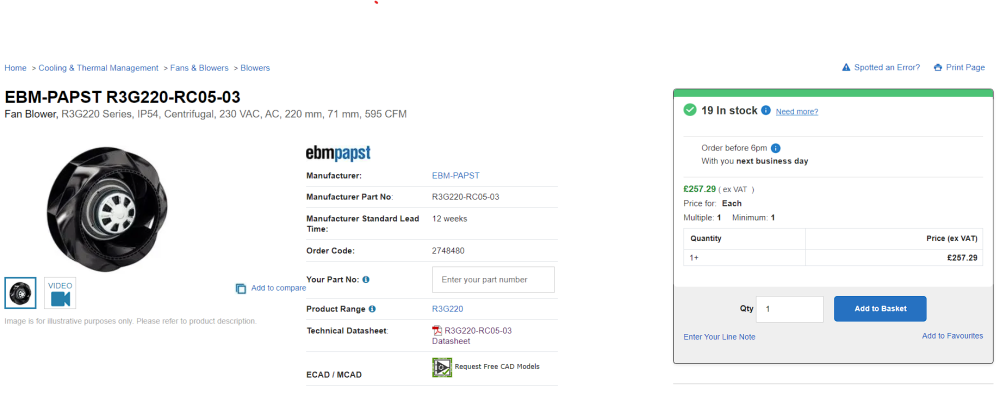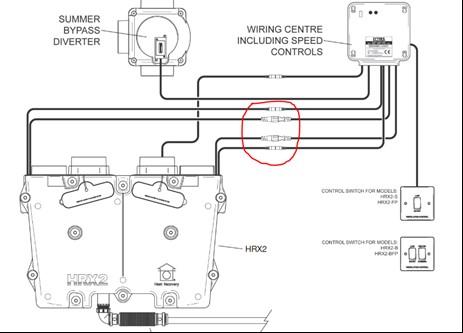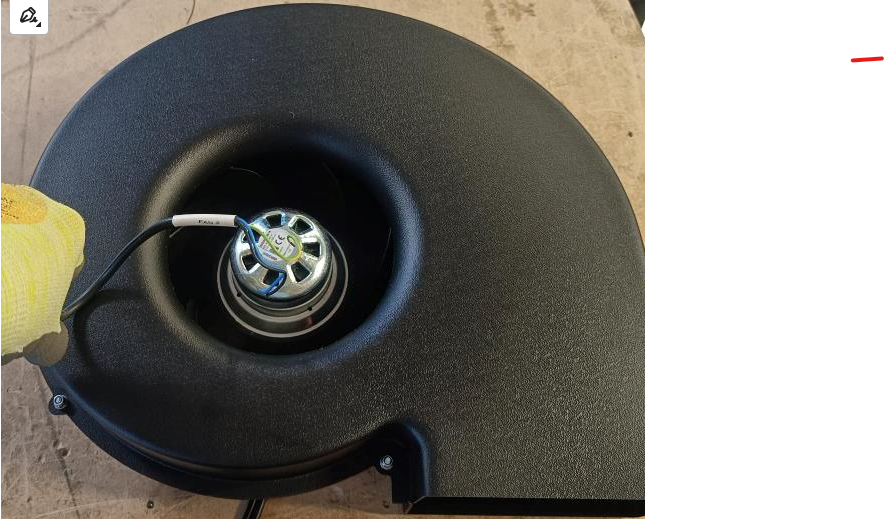
Steve W
Members-
Posts
45 -
Joined
-
Last visited
Everything posted by Steve W
-
Has anyone used this insulated 4 bore pipe
Steve W replied to Post and beam's topic in Air Source Heat Pumps (ASHP)
I've used the two pipe Mibec which is very good. The 2 x 25mm data and cable pipes may not be sufficient depending on the heatpump. In the case where the ASHP communicates to a control box in the house with a data cable and the internal control box controls the system then only a single data cable is required plus power for the ASHP. I swapped from an early Daikin to an Altherma 3 which requires multiple cables as there is no control box in the house - all functions are performed at the ASHP. Additionally with the Altherma 3 you are looking at multiple power cables - ASHP + immersion. I opted for a 50mm flexible conduit and a Mibec with 2 pipes. -
Daikin heating and circulating water when no demand
Steve W replied to Steve W's topic in Air Source Heat Pumps (ASHP)
Just thought I'd post an update. After some to-ing and fro-ing the supplier agreed to swap out the ASHP for an Atherma 3. I have now had the replacement for nearly 12 months and I'm happy to say that the unit has worked flawlessly and does not exhibit the "ice cube" problem of the previous unit. -
Matters have taken a turn for the worse! Previously the noise from the MVHR was merely annoying - yesterday it became louder and I have to switch it off at night. I ordered the bearings from Bolton Bearings so should be here in the next couple of days. I had noticed that the bearing has extra clearance and will report back if the clearance is an issue. It's a surprisingly common bearing and used in lots of application which presumably is why it is so plentiful and cheap. The next generation of fans will probably have bearings that are not removable and are a custom size - after all you want people to buy the expensive fans.
-
Replace MVHR every 10 years?
Steve W replied to TheMitchells's topic in Mechanical Ventilation with Heat Recovery (MVHR)
See my other posts as this provides further information on the motor, bearings and suppliers. -
Replace MVHR every 10 years?
Steve W replied to TheMitchells's topic in Mechanical Ventilation with Heat Recovery (MVHR)
I have a DOMUS HRXD installed in 2018 - at least one of the bearings has gone noisy. I contacted the manufacturer with regards to a new fan assembly and was told the fan assembly was no longer available but the fan from the HRX2D was the same apart from the electrical connection. I enquired at two DOMUS suppliers and was quoted £500.00 and £650.00 for a single replacement part. Essentially it is nearly as cheap to buy a brand new Vent Axia MVHR which has cheaper spares than replace the fan assembly. So Yes, there is very little in an MVHR but the fan units which are expensive to replace (if available - HRX2D is nearing the end of its sales life) and are only as good as the bearings in the motor. I am currently exploring replacing the bearings in the motors or buying the naked fan unit - failing that it's a new Vent Axia. -
Thanks for the update - that fan looks totally disgusting! I have had a look at the YouTube video (https://youtu.be/QmdSoj7Gr90) and its looks to be a straight forward job using 8 x 22 x 7 bearings (608 series). I have had a look through the various bearing suppliers and I will be buying 4 x SKF E2.608-2Z/C3 given that they have an excellent specification. SKF Energy Efficient Bearings - Optimized to increase service life SKF Energy Efficient (E2) deep groove ball bearings can provide more than twice the service life while reducing energy use and total cost of ownership. Design improvements reduce frictional losses in the bearing by at least 30% when compared to the same size SKF Explorer bearing. This results in energy savings over the life of the application. Benefits Longer Bearing Service Life Longer Grease Life Reduced Operating Temperature Higher Speed Capability Sustained Performance Reduced Energy Use Lower Cost of Ownership Boundary dimensions in accordance with ISO15 - which makes them dimensionally interchangeable with standard deep groove ball bearings Reduce Friction Means Increased grease life and service life Optimized to reduce frictional losses and operating temperature in the bearing, capped SKF Energy Efficient deep groove ball bearings can last at least twice as long as comparable SKF Explorer bearings in many applications. This means that in applications where conventional bearings fail and are replaced, the longer service life of SKF E2 bearings could potentially halve the number of bearings consumed over the machine lifetime or even eliminate the need for replacement altogether. In instances where an application is run-to-failure, SKF E2 bearings could conceivably double the life of the application, consequently reducing the total cost of ownership. It would appear from the YouTube comments that life expectancy of bearings is of the order of 4.5 years.
-
Hi Iain, It may be some time before I will be stripping down the MVHR unit - bogged down in flooring at the moment. The picture is from the instructions I got from Domus on how to the replace the fans. I have attached the guide as it may make it slightly easier. Steve W Domus Ventilation - Changing HRX2D Replacement Motors - SPR425-SPR426 (1).pdf
-
I've just had another price for the two fan units, £1300.00 inc VAT plus delivery. Hopefully they should be standard bearings which are freely available. I use simply bearings that offer a next day service and have top notch makes. It will be mid to end March before I can strip the unit too many other jobs now im retired. Will document the process to help others.
-
I have a Domus HRX2 MVHR that I installed in 2018. It would appear that one of the fans has started to fail and although it is not noticeable during the day, during the night it is audible and makes getting back to sleep difficult. I have been in touch with Domus and they have told me that the fans for this unit are no longer available however the fans from the HXR2D are mechanically the same - different connector (I'm a retired electrician so this isn't a problem). The parts are SPR425 and SPR426with a price of £409.75 each + VAT and £10.00 delivery. The original unit only cost j£1073.00 inc VAT and delivery so nearly a £1000 pounds for fans seems exorbitant. Has anybody had any dealings with these fans? Is it possible to replace the bearings as I've seen another post where standard bearings from Amazon have been used to remediate a problem? Are there any firms that specialize in reconditioning these units? How long should a fan last that runs continuously? Would a Nuaire MRXBOXAB-ECO2 be a suitable replacement albeit I would need to rework the pipework slightly. Given the cost of two fans I am seriously considering replacing the unit with one from another manufacturer that has more cost effective spares. Any advice would be greatly appreciated. Steve W I have access to bearings pullers and a vast array of tools as well as a mate who has machining facilities if needed
-
More Octopus ASHP questions.
Steve W replied to lakelandfolk's topic in Air Source Heat Pumps (ASHP)
I have a Solar iBoost that connects to the single emersion heater which heats the water to 60C+ on a sunny day. The legionella functions in the ASHP are disabled and there in no connection from the ASHP to the DHW immersion heater. -
Daikin heating and circulating water when no demand
Steve W replied to Steve W's topic in Air Source Heat Pumps (ASHP)
I don't believe that the engineer turned the freeze prevention off completely but I can't be certain as the weather has been quite mild. He didn't leave a new system config report and he didn't update any existing documentation either. -
I have an Octopus ASHP which uses a 25amp RCBO in a spare way in the CU. In order to satisfy their anti-surge requirement they fitted a whole house anti surge enclosure between the meter and the consumer unit which was a bonus. Didn't make a big deal over it.
-
Daikin heating and circulating water when no demand
Steve W replied to Steve W's topic in Air Source Heat Pumps (ASHP)
Yes, this is a hidden gotcha. I couldn't work out why in scheduled mode there wasn't an OFF and that the lowest temperature was 15C. The net effect is that you are paying for the pump and also heating the water in the loop. As my water temperature is set to 45C it would circulate water at 35C whether the unit was on or off! After the visit from Daikin the temperature was adjusted and now it tends to be just the pump. This ASHP seems to have all manner of quirks which means that 95% of the time it is fine and the other 5% I may as well switch it off. -
Daikin heating and circulating water when no demand
Steve W replied to Steve W's topic in Air Source Heat Pumps (ASHP)
After a significant amount of digging it appears that if the water temperature drops below 15C that the unit has real problems in cold weather. The optional backup is heater is not so optional especially during defrost cycles. Can Daikin Altherma be delivered without a backup heater? No. The backup heater must be installed to ensure that the water temperature never drops below 59ºF (15ºC) during startup of the system or during defrost. This was in the FAQ for North America. -
Which ASHPs are more prone to defrost cycles
Steve W replied to Steve W's topic in Air Source Heat Pumps (ASHP)
Both Daikin and the installer are coming out next week. On a day with 75% humidity, and -2C the house is 21 C in the morning, defrost cycle greater than 60minutes. At 94% humidity and -0.5C the temperature is the same as when it started and the defrost cycle is every 25minutes. The area is about 75sqm and the temperature ask is about 1.5C as in the starting temperature is 19.5C. The temperature here at, 6.30pm 10th March, is -2C and the humidity 85% and the defrost cycle is more than an hour, room temperature is 20.5C. Tonight I am expecting -10C so should be interesting. -
Which ASHPs are more prone to defrost cycles
Steve W replied to Steve W's topic in Air Source Heat Pumps (ASHP)
The 7kW heat pump I have is more than sufficient for the house and indeed heats the house more than adequately even when the weather is below zero. My original question was trying to determine if other makes / models of heat pump have defrost cycles as low as 25 minutes when the humidity is above 90%. What I can't find anywhere is the fine print that states only to be used in non humid conditions because you won't get an LWT of 45C. -
Which ASHPs are more prone to defrost cycles
Steve W replied to Steve W's topic in Air Source Heat Pumps (ASHP)
Agreed, there is only one LWT (at a time). The second 0V contact tells the ASHP to use the second setting which I will set to 45C. I run the system serially Hot Water -> UFH -> radiators and if necessary, which it usually isn't, a period in the afternoon. The downstairs of the house coasts from 6.30 a.m. till the next heating cycle 12.30 a.m. using the thermal mass of the house and slab - the room that I use most, in the evenings, is usually around 21C and rises to 21.5C with the television on. The South side of the house has a very high solar gain as it is mainly triple glazed which is not on the SAP report - this does mean that on a sunny day in winter that the house can get to 24C+. I also have 5 x 3.5 kWh of battery (and 4kW solar + Solar Boost) that I use if the house needs any additional heat. Typically the electricity consumption (heating, lighting, cooking, general use) for the house is 30-35kW at 14p/kW (economy 7). There is a very interesting post https://lamiacasaelettrica.com/daikin-defrost-a-conscious-choice/ where the 25 minute defrost cycle is analyzed in some depth. Although not exactly the same model is of the same technology. -
Which ASHPs are more prone to defrost cycles
Steve W replied to Steve W's topic in Air Source Heat Pumps (ASHP)
Hi Dave - thank you for your help and input. At the moment I'm stuck with a single LWT setting for two conflicting requirements - namely UFH (low temperature) and radiators (higher temperature). At one point I was running at a lower temperature and then when I woke up I would adjust the temperature back up to 45C for a couple of hours. The installer is still working on the problem and has had Daikin onsite - muttering about potentially not enough refrigerant. Daikin have said that they will come back and check the refrigerant but only after the installer has done their bit. The Daikin unit itself is capable of having two LWTs this is controlled by two zero volt contacts on the PCB. Time permitting I will swap to two LWTS, UFH set to 35C and the radiators set to 45C - by which time I will have switched the whole system off for the summer. -
Which ASHPs are more prone to defrost cycles
Steve W replied to Steve W's topic in Air Source Heat Pumps (ASHP)
Going back to my original question. Is this heat pump more prone to icing up than any other heat pump? A 7KW heat pump is appears to be more than adequate for the size of the house given the insulation and air tightness. The original calculations from Polypipe were 5KW but I added more insulation. Two people sitting in the television room with the TV on in the middle of winter raises the temperature of the room. Given the wrong conditions e.g. 0C and high humidity it is estimated that overall the output of the ASHP is essentially 43% - hence slow puncture syndrome. -
Which ASHPs are more prone to defrost cycles
Steve W replied to Steve W's topic in Air Source Heat Pumps (ASHP)
I've attached the SAP (as built) summary and the Performance Estimate from the installer. The house overall is A rated, high airtightness (2.38) and 94% MVHR. The heat loss is low and is why it took me several days to realize that the house temp was gradually falling - a bit like a car with a slow puncture. Last night the outside temperature was 1C but the humidity was considerably lower than it has been 83% - the heat pump performed flawlessly and the house is essentially the same as yesterday. Steve W SAP Extract.pdf Performance Estimate - J-669BD82E_Redacted.pdf -
Which ASHPs are more prone to defrost cycles
Steve W replied to Steve W's topic in Air Source Heat Pumps (ASHP)
When the problem has been most acute the only way to bring the house back up to any semblance of normality is run a subset of the zones. It still goes through defrost cycles but by and large achieves the required temperature. Strangely the hot water which is on a fixed time slot (12.30 to 2.00) always achieves 45C with a 250L tank. I live in what in an area that was predominantly Cotton Spinning and cloth manufacture which is known for its above average humidity. I am was one of the first installations installed by the company and they may not have been aware of the potential humidity issues. Do some ASHPs come better with high humidity if not what is the solution? Higher output unit or reinstall my gas boiler that I still have. Suggestions please





